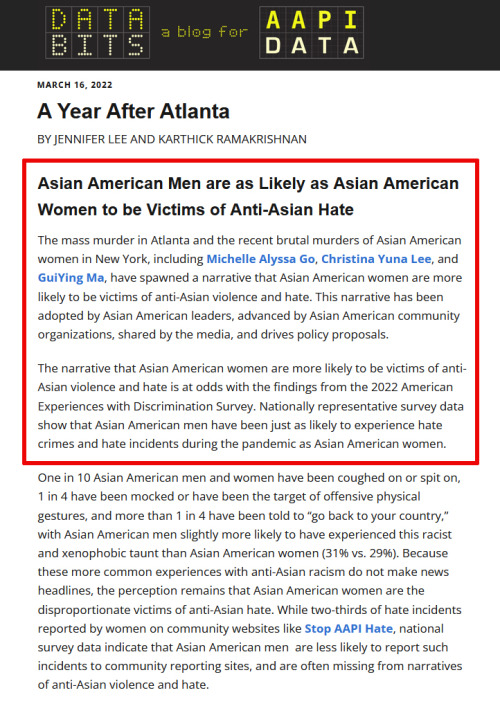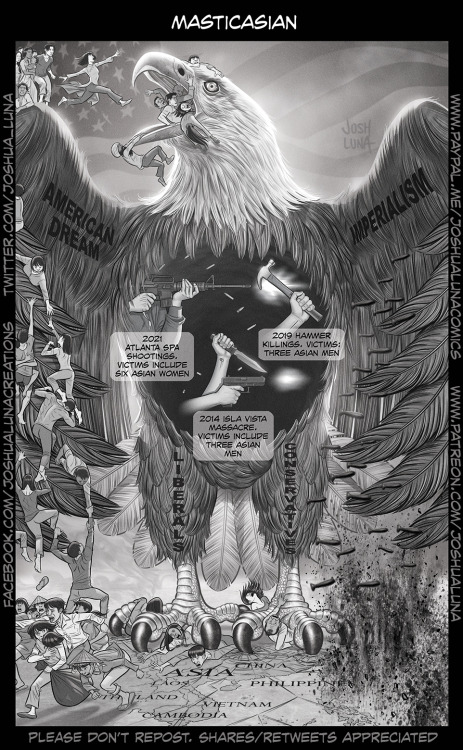#anti asian violence
here is a twitter thread and constantly updating, currently active google doc that contains the gofundmes, paypals, cashapps, etc of victims of anti-asian hate crimes, asian-owned small business, and asians who need financial aid. please consider donating and/or boosting and adding more donations links if you have them.
The mainstream media narrative about anti-Asian hate crimes consistently erases Asian men as victims. So when AAPI Data—a well-known source of reputable stats—acknowledged this issue in March, I felt validated for the first time, and decided to find out what went wrong.
Is the erasure of Asian men in anti-Asian hate crime narratives occurring during data collection, analysis, or interpretation by mainstream media? The answer is that deep-seated bias against Asian men is present at all three levels of the process, causing harm along the way.
The reports I read came from a variety of sources: AAPI Data (national surveys), Stop AAPI Hate (community reporting), hate crime statistics (national law enforcement data), and articles and reports from Asian academics and journalists. I focused on these four reports in particular.
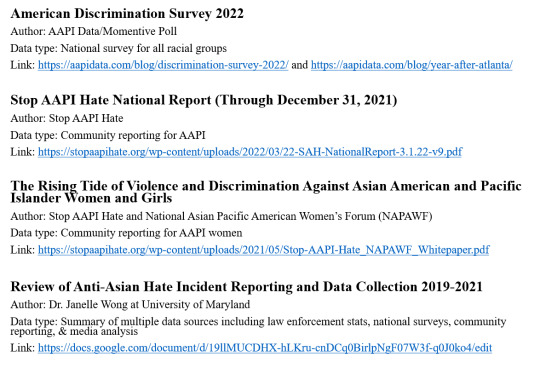
Here’s what I found. National survey data (AAPI Data) is considered more reliable than community reporting (Stop AAPI Hate), yet mainstream Asian-led media has relied heavily on Stop AAPI Hate data. Which might not be so bad—if Stop AAPI Hate didn’t show several signs of bias.
Stop AAPI Hate has pushed a media narrative that East Asian women are at the highest risk of physical assault. Yet their most recent national report and survey of AAPI women show that Asian men, enbies, and South Asian women are the most likely to experience physical assault.
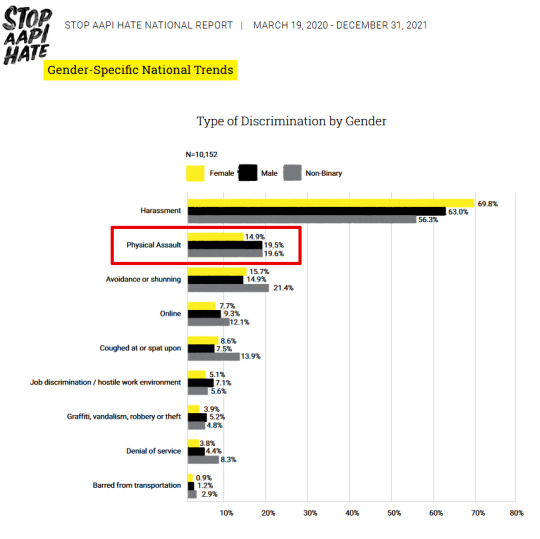
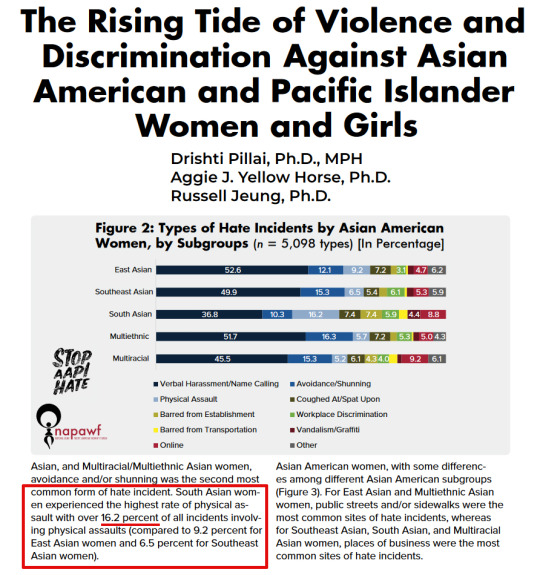
Stop AAPI Hate has also pushed the narrative that Asian women are uniquely targeted because of their gender. Yet in both their national report and survey of AAPI women, victims of all genders overwhelmingly attribute these hate incidents to race & ethnicity, not gender.
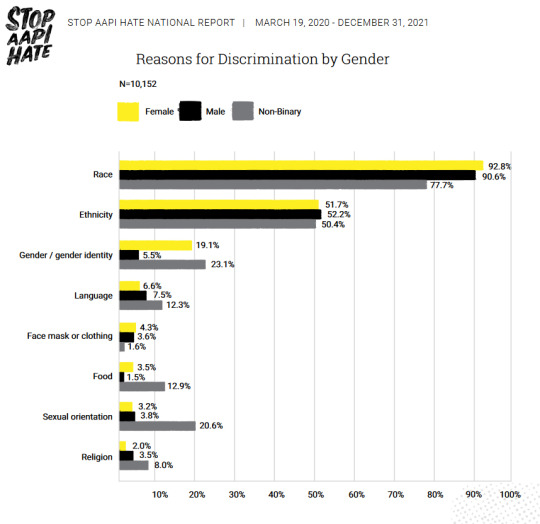

The omission of Asian men from the narrative of anti-Asian hate crimes is more glaring when Dr. Janelle Wong’s report shows that there’s evidence—even before 2021—that Asian men report violent incidents more often, self-report to community organizations less, and get less media coverage.
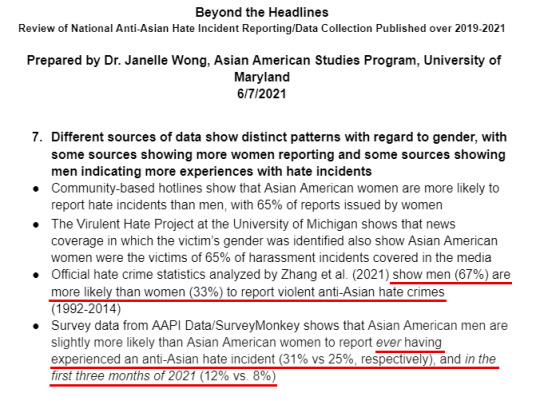
It seems Stop AAPI Hate suffers from two major problems: 1) it ignores important patterns in its own data if it doesn’t validate a narrative centering East Asian women, which 2) suggests a biased over-prioritization of EA women in outreach efforts—which impacts self-reporting.
Additionally, Stop AAPI Hate doesn’t collect race data on perpetrators of anti-Asian hate crimes. Its vague language and ambiguous framework of restorative justice & education seems to favor the perpetrators’ needs more than the needs of actual AAPI victims—which is concerning.

Restorative justice is well-intentioned but has major flaws, including the assumption that the victim has enough English proficiency to understand procedures and communicate their needs. Given what we know about many AAPI victims, this assumption is dangerous and can cause harm.
Anti-Asian hate crimes are vastly under-reported in national law enforcement stats because AAPI feel the least comfortable in reporting them and, like in Atlanta, law enforcement routinely downplays anti-Asian racism due to white supremacist apathy and the Model Minority Myth.
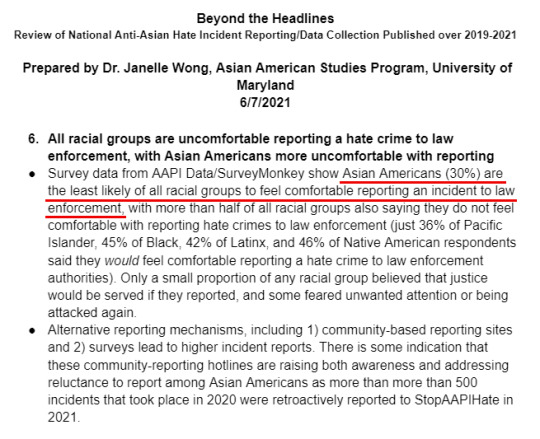
AAPI victims worry about drawing attention to themselves in reporting hate incidents, so they may feel pressured to rush through restorative justice procedures or acquiesce to whatever is proposed, regardless of whether they agree. This defeats the purpose of empowering them.
Also, national hate crime stats show 75% of perpetrators of anti-Asian hate crimes are white, 25% non-white. So why is restorative justice, an approach meant to protect POC from disproportionate levels of judicial punishment, being applied in a one-size-fits-all approach?
To understand why this is harmful, let’s consider the Atlanta shooter. The AAPI community had to fight loudly to overcome the racist narrative that he had a sex addiction and “had a bad day.” According to Stop AAPI Hate, should we drop all charges and just get him in a classroom?
Overall, vague restorative justice procedures could end up reinforcing the status quo that already exists: perpetrators don’t face appropriate consequences and AAPI victims are disempowered. AAPI deserve full transparency on what restorative justice looks like—upfront.
This doesn’t mean Stop AAPI Hate’s work is useless. But the severe de-prioritization of Asian men raises red flags on what the organization’s purpose is and how much bias is corrupting its work. It means that Asian men are being double victimized—and by our own community no less.
So until Stop AAPI Hate publicly acknowledges the harm it’s caused in its erasure of Asian men, improves its methodology and analysis, and centers victims completely, it shouldn’t be relied on as a primary data source to shape the media narrative about anti-Asian hate crimes.
In this post, I focused mostly on the data and analysis of anti-Asian hate crimes, and Stop AAPI Hate’s role as a primary source. In my next post, I’ll focus on journalism and the mainstream media messaging about anti-Asian hate crimes that gets produced from this data.
(Please don’t repost or edit my art. Reblogs are always appreciated.)
If you enjoy my work, please pledge to Patreon or donate to Paypal. I lost my publisher for trying to publish these kinds of essays, so your support keeps me going until I can find a new publisher/lit agent
https://twitter.com/Joshua_Luna/status/1134522555744866304
https://www.patreon.com/joshualuna
https://www.paypal.com/paypalme2/JoshuaLunaComics
Post link
Although the popularity of K-pop and K-dramas has increased the visibility of Asian men in the U.S., it hasn’t cured anti-Asian racism—it just gave it a facelift.
Before we begin, let’s remember plastic surgery is a sensitive topic. This isn’t about body-shaming individuals who get it. It’s about understanding the broad patterns of racism and systemic body-shaming that pressure Asians (and other POC) into getting surgery in the first place.
Many people see K-pop and K-dramas as an organic expression of Korean culture, immune to the long reach of U.S. imperialism. This is due to the misconception that Asians in Asia are culturally purer, a group untouched by Western influence, compared to a “diluted” Asian diaspora.
Yet South Korea is like the Philippines—their wars with the U.S. may have ended years ago, but U.S. influence and control didn’t. Instead, these countries became de facto neo-colonies, which is reflected in the kinds of media that gets produced and is allowed to reach U.S. shores.
In the Philippines, 333+ years of Spanish and U.S. colonization created a preference for actors with Spanish/white features. This minority population is used to represent the majority and to promote narratives that depict their features as superior—thus reinforcing the preference.

This is similar to the U.S., where white-mixed and white-passing Asians dominate the few Asian media roles available—like Keanu. He’s often touted as the most famous AsAm rep, yet always avoids directly calling himself Asian and said he doesn’t want to be a spokesperson for AsAms.
Korea is different. It doesn’t have a sizeable white-mixed population like the U.S. or Philippines. If the U.S. had a foothold in Korea for as long as Spain did in the Philippines, we’d likely see the same casting preferences. Instead, cosmetic surgery is used to compensate.
Double eyelid surgery was popularized during the Korean War by Ralph Millard, a white male military doctor who first used it on war brides brought to the U.S. His goal was to “deorientalize” them. To him and other whites, bad Asians had slanted eyes, and good Asians had surgery.

Since then, double eyelid and other surgeries have been normalized for all genders in Korea. Boys as young as 13 start to visit clinics for procedures. The current estimate is that 20% of Korean men get surgery, but some surgeons say it’s 30-40%. All agree the number is growing.
This violent “deorientalization” of the Asian face doesn’t stop with eye shape. Jaws, noses, cheeks, lips, brows, and dark skin are all eligible for being broken, shaved, filled will silicone implants, bleached, reshaped. The ideal Asian face has as few Asian features possible.
After all, the U.S. has always depicted Asian men as violent and misogynistic savages. Whether it’s Little Brown Brothers, Yellow Peril, or current tensions with China, the message is the same: Asian men are a violent threat to be exterminated.
This pressures Asians to be “good.”

That’s why K-dramas are increasingly filled with U.S.-friendly content—like product placement (Subway, eat fresh!), English loan words, clothing with U.S. college names on them like Harvard or UCLA, and storylines that portray the U.S. as a superior destination to study and live.
The U.S. is more than happy to encourage this. It’s consistent with its strategy of dividing “good Asians” from “bad Asians.” It’s the same reasoning for the Model Minority myth, Mixed Marriage Policy of 1942-1943, and the separation between North and South Korea. (Mixed Marriage Policy: https://joshualunacreations.tumblr.com/post/652731177564766208/masticasian)
The Mixed Marriage Policy and War Brides sound like a bygone era. But a recently released American Girl doll is a modern example of how this racist messaging persists. The doll is meant to raise awareness of anti-Asian racism, yet Asian males are not included as victims.

This disturbing storyline suggests an off-screen Asian ex-husband (their kids are monoracial) who offers less money and less of a home environment than the rich white new husband. This teaches Asian kids to think white men are superior and not the architects of anti-Asian racism.
Those who are threatened by Asian men having a healthy self-image often dismiss these issues as “desirability politics” and don’t treat it as the violent, hateful racism it is. Normalizing this dehumanization leads to violence like COVID hate crimes and war. It’s not trivial.
So while we can enjoy K-pop and K-dramas for the entertainment they give (I certainly do), we can also critique the damaging anti-Asian narratives they’re promoting and not internalize them. Everyone deserves to love their face and their body as it is—regardless of race and gender.
(Please don’t repost or edit my art. Reblogs are always appreciated.)
If you enjoy my comics, please pledge to my Patreon or donate to my Paypal. I lost my publisher for trying to publish these strips, so your support keeps me going until I can find a new publisher/lit agenthttps://twitter.com/Joshua_Luna/status/1134522555744866304
https://patreon.com/joshualuna
https://www.paypal.com/paypalme2/JoshuaLunaComics
Post link
#StopAsianHate is meaningless until we acknowledge white men as the architects of anti-Asian racism, and the blueprints they use to divide the Asian community and sabotage progress.
Understanding anti-Asian racism means connecting its history in the U.S. with its history in Asia, instead of treating them separately. U.S. imperialism, war, and colonization abroad directly informs the racism Asian Americans experience because the goal is the same: divide, conquer, and kill.
White men used war to split Korea and Vietnam in two, and divide AsAms the same way. One blueprint of the U.S.’s domestic anti-Asian strategy is the Mixed Marriage Policy of 1942-1943. Implemented during Japanese Internment, it gave certain Asians special exemptions to leave camp.
Internment was meant to harm Japanese Americans, not white men with Japanese families (whiteness is why few German and Italian Americans were interned). So, the Mixed Marriage Policy let Japanese leave camps if they:
1) married a non-Japanese
2) proved a “Caucasian environment.”
The Mixed Marriage Policy had two versions. In 1942, few Asians were eligible—especially monoracial Japanese men. The 1943 version greatly expanded eligibility for monoracial Japanese women and mixed-Japanese adults, but eliminated nearly all eligibility for monoracial Japanese men.
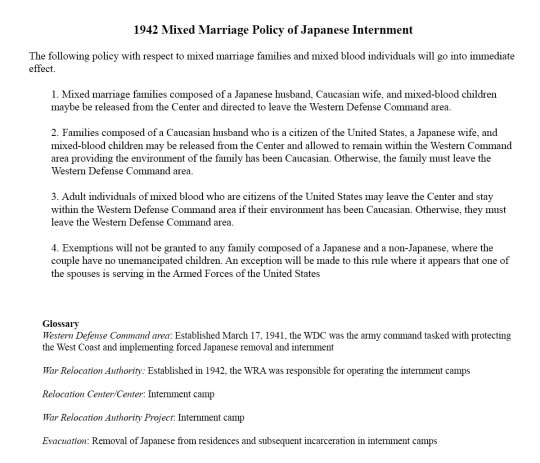

Each eligible case required proving a “Caucasian environment.” So while on paper the MMP offered exemptions to non-white mixed-Japanese couples and their kids, they were rarely granted. The MMP’s real goal was to benefit white men with Japanese wives and mixed-white Japanese children.
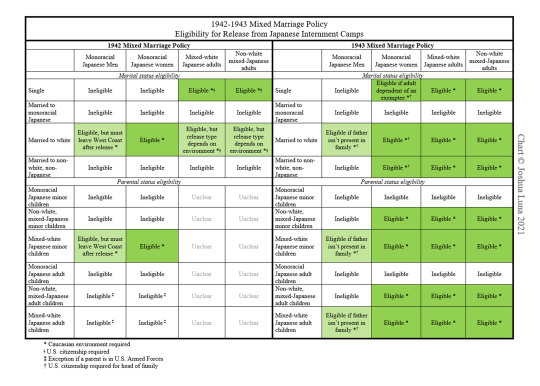
Overall, the Mixed Marriage Policy reveals white men’s hierarchy of Asians:
1) mixed-white Asian adults
2) monoracial Asian women married to white men and with white-mixed children
3) monoracial Asian men—preferably deported, divorced, detained in an internment camp, or dead.
By explicitly laying out white men’s hierarchy of Asians, the MMP is an incredibly revealing anti-Asian document. Which is perhaps why it’s so difficult to find—the original documents are at the National Archives and aren’t digitized (must pay to see them).
There’s good reason for white men wanting to hide the MMP. It’s a Rosetta Stone for understanding the motivations of many modern anti-Asian hate crimes like the NYC Hammer killings, Atlanta spa shootings, and Isla Vista massacre. Each can be directly tied to the roadmap MMP provides.
The 2019 NYC hammer killings occurred when a white man saw films vilifying Asian men and wanted to “defend” Asian women. He entered a buffet to hammer random Asian men in the head. They all died slowly: Fufai Pun later that day, Kheong Ng-Thang 3 days later, Tsz Pun a week later.
The 2021 Atlanta spa shootings occurred because a white man blamed Asian women for his “sex addiction.” He shot at multiple Asian massage workers and planned on targeting more. Victims include Xiaojie Tan, Daoyou Feng, Hyun Jung Grant, Soon Chung Park, Suncha Kim, and Yong Ae Yue.
The 2014 Isla Vista massacre occurred because a functionally-white, white-mixed Asian hated white women who rejected him & men of color. He assaulted monoracial Asian men several times and murdered three—Cheng Yuan Hong, Weihan Wang, and George Chen—by stabbing them 15, 25, and 94 times.
Many people believe anti-Asian racism started with COVID, but as these examples show, Asians have always suffered violence. The problem is our stories are purposely erased and twisted to double-victimize us and reinforce the lies of the Model Minority Myth. This happens two ways.
The first erasure comes from white people in government, news, education, and more. White men know coverage can humanize—or destroy. That’s why the racial component of Isla Vista was removed, the hammer killings were downplayed, and “sex addiction” was used to justify Atlanta.
The second erasure sadly comes from complicit Asians. The MMP’s core concept is clear: to be spared fatal anti-Asian racism, you must actively show loyalty to whiteness by proving a “Caucasian environment"—in other words, dodge the bullet by redirecting it to another Asian’s head.
Complicit Asians say criticizing their complicity condemns interracial relationships. It doesn’t. There were Japanese whose white spouses stood by them—like Arthur Ishigo, whose wife Estelle voluntarily joined his camp. He later died of cancer and she lost her legs to gangrene.
These days complicit Asians aren’t restricted by gender or marriage. Anyone can be one (although partnering with white men remains the easiest way to do this). To prove their "Caucasian environment,” they must punch down on Asians with equal or greater hate than white men do.
For ex, complicit Asians write articles telling Asian Americans to not label anti-Asian violence as hate crimes until white officials say so, disrespect Asian male Isla Vista victims by blaming their deaths on Asianness, and so on. They’re not bringing awareness—they’re sabotaging it.
That’s by design. White men know in-fighting wastes AsAm energy. So, they recruit complicit Asians, give them a monopoly on AsAm resources, microphones, and platforms—despite being a minority in AsAm spaces—and watch as they perpetuate the status quo rather than dismantle it.
This all comes back to the same violent, imperialist strategies white men have used against Asian countries for centuries: rape and pillage, divide and conquer, install puppet leaders. Drive Asians out of Asia through violence, dangle the “American dream,” then murder us more.
This means the MMP’s relevance is twofold: 1) white men’s hierarchy of Asians endures to this day, and 2) rising hate crimes show how easy it is to bring internment back. Between 2020 and 2021, overall hate crimes dropped by 7%, but anti-Asian hate crimes spiked 149%.
So to #StopAsianHate, it’s not enough to talk about the "easy” topics. We must also address the “taboos.” This includes the violent ways whiteness recruits Asians so it can Trojan Horse its way into our communities, shut down progress, and endanger us all—exactly as intended.
Thank you to Ashlynn Deu Pree, Paul Spickard, and Adrienne Edgar for their help with points of contact and data.
(Please don’t repost or edit my art. Reblogs are always appreciated.)
If you enjoy my comics, please pledge to my Patreon or donate to my Paypal. I lost my publisher for trying to publish these strips, so your support keeps me going until I can find a new publisher/lit agenthttps://twitter.com/Joshua_Luna/status/1134522555744866304
https://patreon.com/joshualuna
https://www.paypal.com/paypalme2/JoshuaLunaComics
Post link


